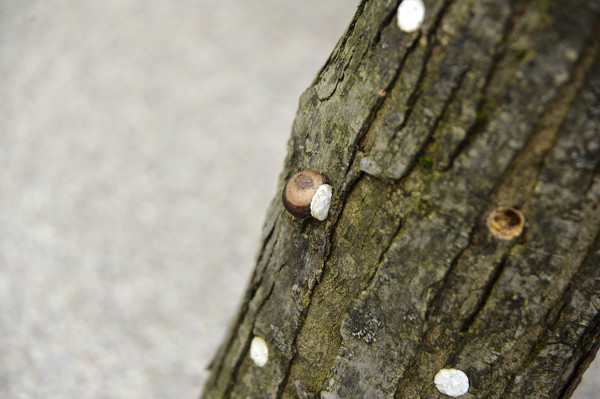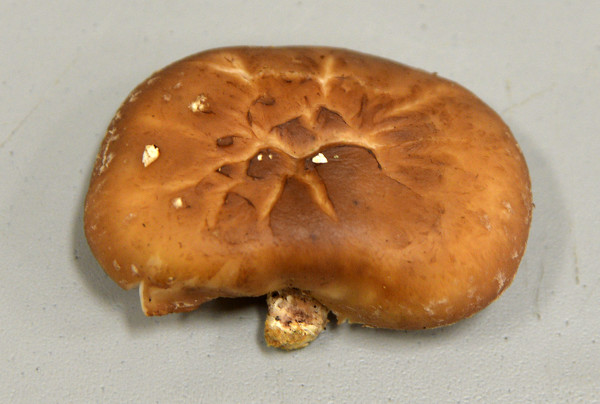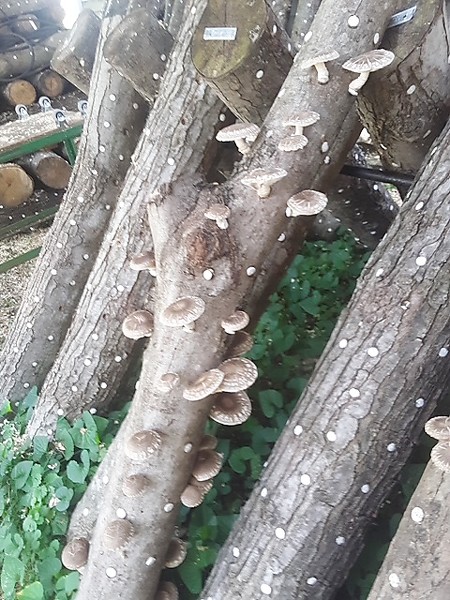Saturday, December 17th, 2022
A fun guide to fungi
Grow mushrooms at home with moisture, time
By Leslie Gartrell

Photo by Leslie Gartrell/The Daily Standard
A young shiitake mushroom peeks out from a styrofoam cap on a log during a seminar on how to cultivate outdoor mushrooms in North Star on Friday.
NORTH STAR - Mushroom aficionados can grow and harvest their own protein-packed fungi at home with a little outdoor space, moisture and plenty of patience.
Marc Amante, an agriculture and natural resources educator at Central State University, introduced outdoor mushroom cultivation to a crowd of roughly 20 people at the North Star Community Center on Friday morning.
Mushrooms can be grown outdoors with minimal startup and material costs, and they can be raised in marginal spaces on farms or urban environments, he said.
Amante said mushrooms need a few things in order to thrive: moisture, shade, a lack of competitors and substrate, or feeding material.
Dead plant matter such as straw, wood chips, whole logs, vegetable waste and compost are among the most common substrates, he said.
Mushroom spawn is often purchased from a spawn supplier, such as NorthSpore, Field and Forest or Fungi Perfecti, he continued.
Spawn come in numerous shapes and sizes. Plug spawn, often used for log-based production, consists of small wooden dowels inoculated with fungi. Peg spawn utilizes longer dowels and is used for inoculating mulched beds, he said.
Spawn can also come from colonized sawdust, custom-formed sawdust "thimbles" or colonized grain. He suggested using plug spawn for low quantities and home growing, and sawdust or thimble spawn for high quantities.
Some mushrooms, such as wine cap mushroom, can be planted in the ground in mulched beds layered with straw, wood chips or both, he said. The burgundy-colored capped mushrooms can also be grown in vegetable gardens, fruit shrubs and trees or paths by inoculating mulch with mushroom spawn.
This variety of shroom has a similar flavor to portabella mushrooms and is relatively beginner friendly, Amante said. These mushrooms are great for integrating with mulched vegetable and fruit producing plants, he said, but noted the mushrooms will decompose the mulch more quickly.
Wine cap mushrooms can be planted in the spring or fall, although the educator said he prefers the latter. It can take anywhere from six months to one year before the mushrooms are ready for harvest. Growers can typically expect 1 pound of mushrooms per square foot over two annual harvests, he said.
Depending on when they were planted, wine cap mushrooms will typically be ready for harvest in late April-May or mid-September-early October, according to Amante.

Photo by Leslie Gartrell/The Daily Standard
Flat caps like the cap on this shiitake mushroom indicate it's past peak time to harvest. While it doesn't affect taste or texture, harvesting later than necessary puts the crop at risk of becoming a feeding and breeding ground for fungus gnats.

Photo by Leslie Gartrell/The Daily Standard
This small shiitake mushroom was plucked off a log during the seminar. Shiitake mushrooms are a beginner-friendly mushroom variety.
Other mushroom varieties, such as the warm-weather almond agaricus or the fall-fruiting wood blewit, can be grown in compost piles.
However, Amante spoke at length about the log growing method for those looking to cultivate a wide variety of mushrooms or have almost year-round production.
Many species and varieties of mushrooms can be grown on logs, such as shiitake, oyster, lion's mane and reishi mushrooms, he said.
Different mushroom species need different tree species in order to grow, he said. Spawn suppliers often have charts explaining which trees a species of mushroom can grow on.
Mushrooms can be grown on logs through three different methods, he said. Growers can use log bolts, or tree sections, the most common method; totems, consisting of several layers of large log sections and mushroom spawn and sealed in a bag; or sterilized logs, which requires the logs to be sanitized and sealed in a special, autoclavable bag.
No matter the shroom, Amante said fungi must be grown on logs cut from healthy, living trees. The logs should be mostly free from damage with whole bark and solid all the way through.
Growers could work with a local arborist or forester and offer to cut down small trees in exchange for using the logs, he said.
Logs need to be harvested in the fall, usually when at least 30% of leaves have changed color, Amante said. Once cut, the logs need to rest for one to two weeks to reduce the natural anti-fungal concentrations in the wood.
The logs should be kept in a shady location ideally off of the ground, he said, adding the sooner a cultivator can inoculate after the rest period, the better. Cultivators should aim to provide 1 inch of water per week during the growing season, he said.
The bolt method is very common for mushroom production, Amante said. Shiitake and oyster mushrooms are commonly grown using this method.

Submitted Photo
A log full of home-grown mushrooms by Central State University educator Marc Amante is ready for harvest in this submitted picture.
The bolt method requires tree sections roughly 36-40 inches long and 4 inches in diameter to be drilled with holes in a diamond pattern, about three inches apart.
Plug spawn can be hammered into the holes and sawdust spawn can be pushed into the holes using an inoculation tool, he said. The holes are then sealed with cheese wax, plug wax or special tools.
Logs should be labeled with the mushroom strain, tree species and the date inoculated, Amante said.
The logs can then be stacked in a shaded spot off the ground and watered as needed until the first harvest is ready, typically nine or 18 months depending on the mushroom strain and tree species, he said.
Once a grower has had their first natural harvest, Amante said the logs can be re-used and forced into nearly year-round production.
Forced production calls for strain-inoculated logs to be separated into their own stacks and soaked in cold water for 24 hours. The logs could be soaked in livestock watering tanks, kiddie pools or even natural streams or ponds, he said.
Once the logs have been removed, cultivators can expect fruiting to begin in one to three days and last up to seven to 10 days, Amante said.
After that, the mushrooms can be harvested, the logs can be returned and the process can repeat itself after a seven or eight week period.
Amante said growers can get two or three harvests per log, and the logs will retain their commercial levels of production for three to four years.
Those looking to cultivate their own fungi should keep an eye out for slugs, who are known to munch on mushrooms with voracity, Amante said.
Slugs can be physically removed from the mushrooms or traps can be set, he said.
Fungus gnats are also a problem and lay eggs inside the mushrooms. To avoid them, Amante said growers should harvest their crop regularly, perhaps before the shrooms reach their full potential size, and put into cold storage to halt their growth.
Mushrooms with flat caps should be quickly harvested, Amante said, as the longer mushrooms remain unharvested, the more likely fungus gnats will use the shrooms as a feeding and breeding ground.







